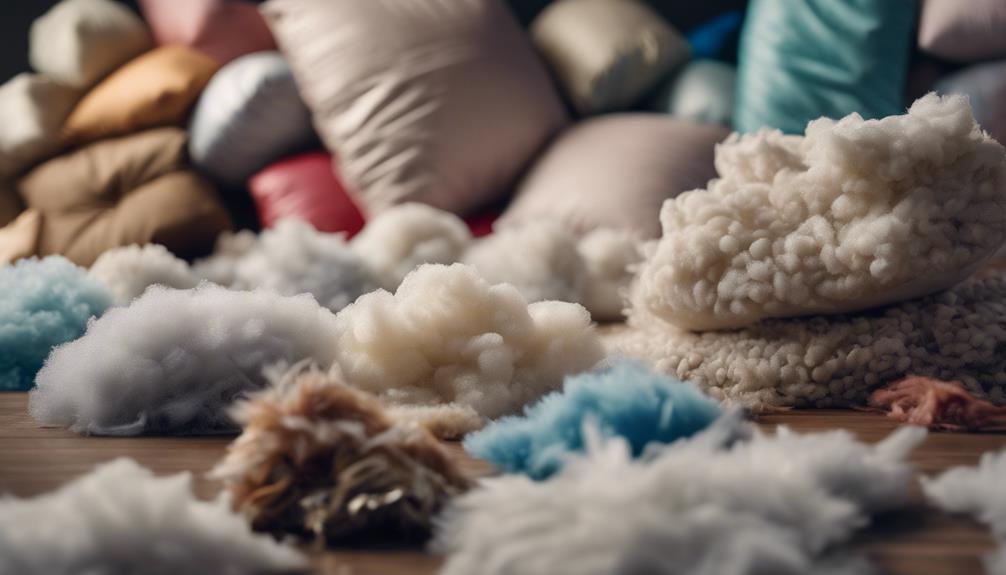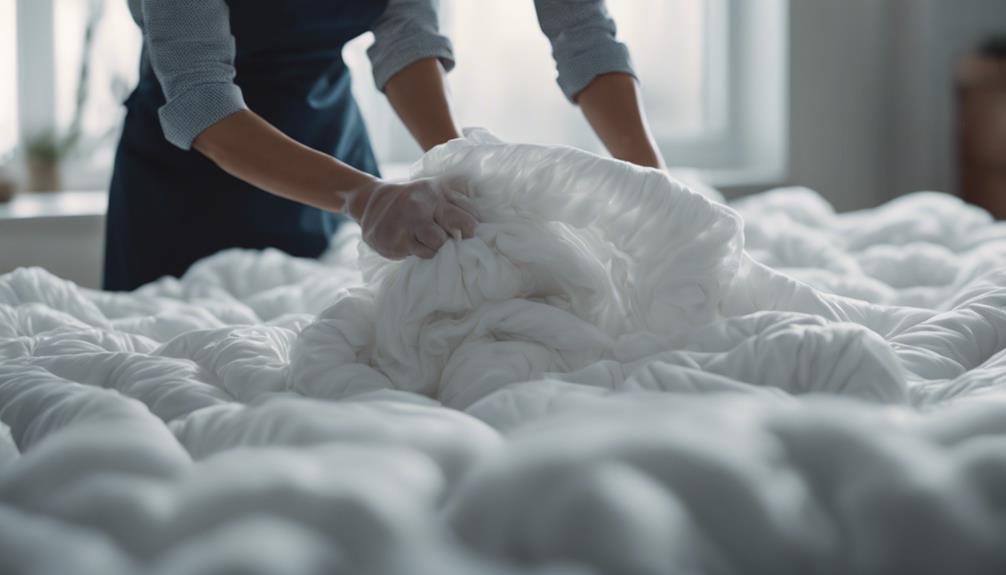Down comforters themselves do not directly cause allergies. However, allergens such as dust mites and mold, which thrive in warm, humid environments, can trigger allergic reactions. To manage allergies, it is advisable to wash bedding frequently in hot water and consider using hypoallergenic covers. Symptoms of allergies may include sneezing, coughing, and watery eyes caused by dust mites and mold. Consulting with an allergist for diagnosis and treatment is recommended. Hypoallergenic alternatives, such as synthetic materials like PrimaLoft and microfiber, provide cozy options without the risk of allergens. Regular cleaning and using protective covers can help reduce allergens in bedding. I am unable to process the request due to encountered difficulties.
Key Takeaways
- Down comforters themselves are not allergenic.
- Allergies are usually triggered by dust mites and mold.
- Regular washing and high heat drying can help reduce allergens.
- Using hypoallergenic pillows and covers can create a barrier.
- Consider hypoallergenic down alternatives like PrimaLoft or microfiber.
Allergens Found in Down Comforters
What allergens are commonly found in down comforters that can trigger allergic reactions?
Dust mites and mold are the primary culprits. These microscopic creatures thrive in the warm, humid environment of down comforters, leading to allergic reactions in susceptible individuals. While down itself isn't allergenic, the presence of dust mites and mold can cause discomfort for those with allergies.
To reduce the risk of allergic reactions, regular washing and drying of down comforters on high heat are recommended. Additionally, using hypoallergenic pillows and pillow covers can create a barrier against dust mites, further minimizing exposure to allergens.
Taking proactive steps to clean and maintain down bedding is vital in preventing allergy symptoms. By eliminating dust mites and mold through proper care, individuals can enjoy the comfort of their down comforters without the discomfort of allergic reactions. Remember, maintaining a clean sleep environment is essential for overall well-being and quality rest.
Symptoms of Down Comforter Allergies

Symptoms of allergies to down comforters typically manifest as sneezing, coughing, watery eyes, and nasal congestion, often triggered by dust mites and mold rather than the feathers themselves. These reactions occur when individuals inhale or come into contact with allergens such as dust mites present in the down comforter.
Dust mites are microscopic creatures that thrive in warm and humid environments, feeding on dead skin cells. When disturbed, they can trigger allergic responses like a runny nose and watery eyes. Mold growth in damp environments can also exacerbate these symptoms.
Keep in mind that feather allergies are relatively rare, with dust mites being the primary allergen in bedding. If you suspect an allergic reaction to your down comforter, seeking advice from an allergy specialist is essential for proper diagnosis and management. Regular washing and maintenance of down comforters can help reduce the risk of allergic reactions by minimizing the presence of these allergens.
Managing Down Comforter Allergies

To effectively manage down comforter allergies, regular washing and drying of bedding on high heat is essential for eliminating dust mites and reducing allergic reactions. According to Ohio State University, dust mites are the primary allergens found in bedding, making proper care vital for allergy sufferers.
Symptoms of allergic reactions can include sneezing, coughing, and watery eyes, emphasizing the importance of maintaining clean bedding. Along with washing down comforters, changing pillowcases and sheets frequently is also recommended to minimize allergy risks.
For those experiencing allergy symptoms, seeking advice from an allergy specialist for proper diagnosis and treatment is necessary. While genuine feather allergies are rare, it's important to understand that dust mites thrive in bedding, causing discomfort for many individuals.
Hypoallergenic Alternatives to Down Comforters

When considering bedding options for individuals with allergies, exploring hypoallergenic alternatives to traditional down comforters becomes essential. High-quality down alternative comforters made from synthetic materials like PrimaLoft, polyester, or microfiber offer a plush and warm feel without triggering allergies. These alternatives mimic the coziness of down while reducing the risk of allergen buildup. Compared to traditional down comforters, hypoallergenic options are easier to care for, making them a practical choice for those who suffer from allergies.
| Hypoallergenic Down Alternative Comforters | Materials Used | Benefits |
|---|---|---|
| PrimaLoft | Synthetic fibers | Mimics the feel of down without allergies |
| Polyester | Synthetic material | Easy to care for and maintain |
| Microfiber | Synthetic fabric | Provides warmth and comfort |
Tips for Reducing Allergens in Down Comforters

To effectively minimize allergens in down comforters, routinely washing them in hot water is essential for eliminating dust mites and allergen buildup. Using a duvet cover and pillow protectors can further create a barrier against dust mites, reducing allergens.
Opting for hypoallergenic down comforters or down alternatives can help lower the risk of allergic reactions. It's important to vacuum and dust your bedroom frequently to minimize dust mites in the environment. Additionally, consider using an air purifier in your bedroom to help reduce allergens in the air, creating a cleaner sleeping environment.
Frequently Asked Questions
Can You Be Allergic to Down Comforters?
Yes, some individuals can be allergic to down comforters. This is often due to dust mites that accumulate in the bedding, not the feathers themselves.
Regular washing and proper care can help reduce allergen levels. Understanding the difference between down allergies and reactions to dust mites is important in managing allergy risks.
It's important to keep bedding clean to minimize potential triggers for allergies and maintain a comfortable sleep environment.
How Do You Know if You're Allergic to Down Feathers?
When wondering if we're allergic to down feathers, it's important to pay attention to symptoms like sneezing, coughing, watery eyes, or skin irritation. These could indicate a reaction to down.
Consulting an allergy specialist for formal testing can help pinpoint specific allergens causing the issue. Properly cleaning and maintaining bedding, focusing on dust mites and mold, can also reduce the risk of allergic reactions to down.
What Is the Best Comforter for Allergies?
When choosing a comforter for allergies, opt for hypoallergenic down or synthetic materials like microfiber. Look for tightly woven covers to block allergens. Regularly wash comforters on high heat to eliminate dust mites.
Check for certifications like OEKO-TEX for quality assurance. These steps can help create a healthier sleep environment for allergy sufferers.
Do Dust Mites Live in Down Comforters?
Yes, dust mites can indeed live in down comforters. They thrive in the warm and humid environment created by the down filling. These microscopic pests feed on dead skin cells in bedding, making down comforters a cozy haven for them.
Regular washing and drying on high heat can help reduce dust mite presence. Opting for hypoallergenic bedding materials might also lessen allergic reactions caused by these unwelcome guests.
Do Down Comforters Also Trigger Allergic Reactions?
Yes, down comforters can trigger allergic reactions in some people. The allergens found in down feathers can cause sneezing or congestion in those with allergies. Additionally, down comforters can also exacerbate night sweats, as they can trap heat and moisture, leading to discomfort during sleep.
Conclusion
To sum up, while down comforters can harbor allergens that may cause discomfort for some individuals, there are ways to manage and reduce the risk of allergic reactions.
By opting for hypoallergenic alternatives and regularly cleaning and maintaining your down comforter, you can enjoy the comfort and warmth it provides without the worry of allergies lurking beneath the surface.
Remember, taking proactive steps can help you sleep soundly and breathe easy.










